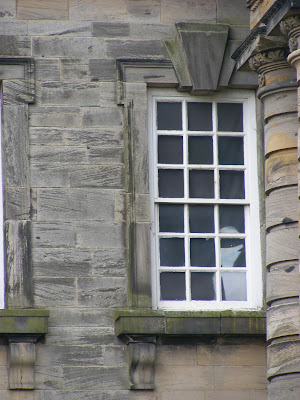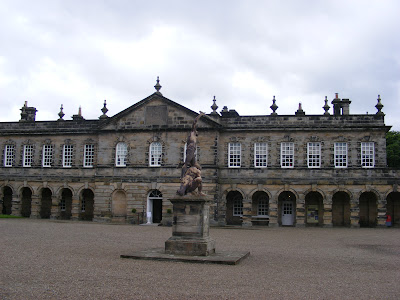 |
| The front of the main hall (but you approach and enter at the back). |
We approached the hall from the meadows at the back (which is actually the front of the building). In between admiring the variety of flowering grasses, stone walls overlooking a horse pasture and some beehives we caught glimpses of this lady in costume.
We were to encounter her and her husband, also in period costume, several times during our visit; both were keen to share their knowledge of the house and its history.
 |
| The Parterre. |
 |
| The hall from the parterre. |
They were originally de Laval, a town in France. According to Wikipedia, the name has died out and been revived a number of times, it being a desirable one by nature of sounding so French (Britain and France do seem have a strange sort of love-hate relationship).
 |
| The Rose Garden & Box Hedge |
The English Delavals over the years apparently weren't great with money and so when bankrupt sold the estate to a wealthy cousin, Admiral George Delaval in the early 1700s.
Admiral George Delaval commissioned the hall to be built by Sir John Vanbrugh, the most famous architect of the day, whose other major commissions include Blenheim Palace and Castle Howard.
 |
| The left of the centre fan-shaped window). |
The style is described as English Baroque.
 |
| The ghost, a lovelorn housemaid, or a play of light on the old window glass. |
Though we spent the better part of the day there we only saw a portion of the place, which having linked to Vanbrugh's other works seems rather cozy and sedate in comparison, though it is quite impressive. Neither Delaval nor Vanbrugh lived to see the Hall's completion.
 |
| I couldn't resist the beauty of this stairwell, though nearer the top you can see evidence of the 1822 fire. |
The house passed to a nephew (Captain Francis Blake who added the name Delaval), then to his son and then to a brother. The family of Captain - later Sir - Francis Blake Delaval and his elder son (who died aged 44 having lived life to the full) were famous for their parties and scandalous behavior, particularly their awful practical jokes. They sound quite foolish altogether, but fortunately the next two sons John and Thomas were of a more serious sort.
 |
| The hall is flanked on both sides by wings, one for people, one for horses. |
John Delaval, the first Baron Delaval was a man with a head for business. He and his brother Thomas developed the local resources of coal, salt and glass and built a harber at Seaton Sluice.
 |
| The hall overlooks the North Sea in the distance. |
He and Thomas fell out later and in any case, Thomas pre-deceased Sir John. The Hall was left to the only surviving brother Edward, a noted scientist who died without issue.
 |
| The stables, built in 1768, were modelled on those of Hopetoun House in Scotland. |
The Hall then passed to the Astleys, the eldest child of Captain Francis Blake, Rhoda, having married Sir Edward Astley from Melton Constable Hall, in North Norfolk. Which, by the way, explains why there is a pub in Seaton Sluice called the Melton Constable; nothing to do with the police at all.
 |
| Home of Regulus. |
 |
| The orangery and the lilly pond. |
Which went to Delaval Astley, 23rd Baron Hastings (b. 1960), a farmer, businessman...and actor...who sold the place to the National Trust in preference to say, turning it into expensive flats. Thank you, Lord Hastings!





4 comments:
Looks like a fascinating place to visit. So nice that your National Trust could afford to buy it.
Beryl - It was amazing; I'd forgotten how much so until going back through my photos. Actually the second link - which has a spectacular photo of the place - explains the history in much better terms than I did, including the fact that several million £ were raised by the local people to ensure Seaton Delaval was acquired.
These gardens are amazing to me. Their neatness and the intensity of the green.
I'm finding myself increasingly seduced by the idea of a trip to the U.K. one of these days. (I've been intermittently immersed in a TV series that takes place during WWII in Hastings, and I feel the pull more and more, as I continue to watch.)
BLW - Knowing what I know now (and that is still of course limited) I would find it even more difficult to know what to see. For such a small place, Britain has an enormous number of fantastic cities/villages/venues to see and enjoy. Good luck choosing!
Post a Comment